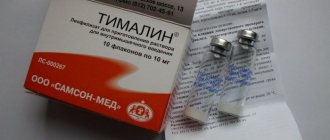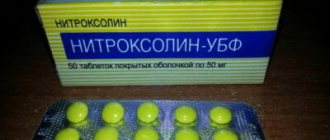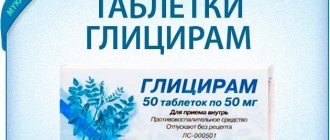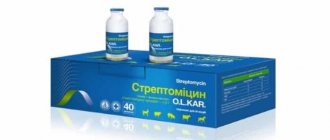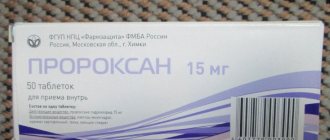Pharmacodynamics and pharmacokinetics
The active ingredient of the drug belongs to the group of sulfonamide antimicrobial drugs. Sulfadimezin is a short-acting drug.
What is Sulfadimezin used for? The medicine is effective against gram-positive and -negative microorganisms. Namely: cocam , Escherichia coli , Klebsiella , the causative agent of anthrax , shigellosis , gas gangrene , plague , pneumonia , chlamydia , the causative agent of toxoplasmosis .
The drug has a bacteriostatic effect. Sulfadimidine inhibits the synthesis of dihydropteroate synthetase through a competitive mechanism, thus disrupting the conversion of tetrahydrofolic acid into purine and pyrimidine bases.
The drug is well adsorbed in the gastrointestinal tract , mainly in the small intestine.
The degree of binding to plasma proteins is 75-86%. The active substance penetrates well into various tissues and fluids of the body and is easily and relatively quickly eliminated. Metabolic reactions occur in the liver tissue. The half-life of metabolites is 7 hours. The drug is excreted through the kidneys.
Release form and composition
Sulfadimezin is produced in the form of tablets: flat-cylindrical, white or white with a slight yellowish tint, with a score and a bevel (10 pcs each in blister packs, two packs in a cardboard pack; 10 pcs in blister-free packs, 500 packs in a cardboard box ).
Composition per 1 tablet:
- active ingredient: sulfadimidine – 500 mg;
- auxiliary components: potato starch, stearic acid, polysorbate 80, talc.
Indications for use of Sulfadimezin
The medicine is prescribed for the treatment of diseases caused by microorganisms sensitive to it.
Indications for use:
- gonorrhea and trachoma ;
- toxoplasmosis;
- diseases of the genitourinary system ;
- infections of the respiratory tract, ears, throat, nose ( sore throat, otitis media, bronchitis, pneumonia, sinusitis, tonsillitis );
- erysipelas , pyoderma , various infectious diseases of the skin and soft tissues;
- shigellosis.
Modern analogues
The following is used as a substitute for a bacteriostatic agent:
- Streptocide;
- Phthalazol;
- Co-trimoxazole;
- Sulfadimethoxine;
- Sulgin;
- Biseptol;
- Groseptol;
- Arghedine;
- Bactrim.
Sulfadimethoxine is available in tablets of 200 mg and 500 mg. The drug is an effective analogue.
The medicine is prescribed for the treatment of:
- upper and lower respiratory tract infections;
- trachoma;
- otitis;
- dysentery.
Phthalazole is a popular analogue of Sulfanilamide, available in 500 mg tablets. The medicine is prescribed for the treatment of intestinal infections. The average course dose is 25-30 g.
Biseptol is an effective analogue, used in the form of tablets of 120 mg, 480 mg. Medicine is prescribed for tonsillitis, sore throat, laryngitis, tracheitis, and lung abscess.
https://youtube.com/watch?v=hykG1OJbokM
Contraindications
The drug is contraindicated:
- if allergic to any of the components of the product, medications from the sulfonamide ;
- children under three years old;
- with inhibition of hematopoietic processes in the bone marrow;
- with azotemia , porphyria , renal failure ;
- if children under 18 years of age have hyperbilirubinemia ;
- with congenital deficiency of glucose-6-phosphate dehydrogenase .
Persons with liver problems or allergic diseases should exercise caution.
Stop fooling yourself
Before reading further, I will ask you 1 question. Are you familiar with this situation when a person has been treated for chronic diseases for years, but there are no results?
Many people who live a healthy lifestyle and eat right do not experience significant improvements in their health due to the presence of parasites. Improving the health of the body through nutrition, exercise, and hardening procedures without first ridding the body of parasites gives a much lesser effect.
Do you think that this definitely doesn’t concern you and that anyone can have parasites, but not you? You are wrong!
If you or your loved ones suffer from “popular” diseases and traditional medicines do not help you, immediately begin cleansing the body.
A proven drug that 'kills' all known parasites is Toximin. This drug is not sold in pharmacies and is not advertised on the Internet, and according to the promotion it costs only 196 rubles.
Read all the information about Toximin on the official website.
Side effects
Sulfadimezine may cause:
- pain in the abdominal area, indigestion , nausea, diarrhea , vomiting, stomatitis , pancreatitis , anorexia ;
- allergies , skin rashes, chills, urticaria , sensitivity to light, toxic epidermal necrolysis , anaphylactic and anaphylactoid reactions ;
- headaches , ataxia , convulsions, various neurological reactions , drowsiness , loss of consciousness, insomnia ;
- depression , hallucinations , vertigo , tinnitus, psychosis ;
- increased levels of liver enzymes, jaundice , hepatitis ;
- agranulocytosis , thrombocytopenia , purpura , leukopenia ;
- crystalluria , nephritis ;
- hypothyroidism , hypoglycemia ;
- sore throat, cough, tachycardia , vasculitis , muscle and joint pain.
Instructions for use of Sulfadimezine (Method and dosage)
Inside.
Depending on the disease and its course, the dosage and duration of treatment may vary significantly.
The average dosage for adults is 4 tablets at the first dose, and then 2 tablets 4-6 times a day. The maximum single dosage for an adult is 2 grams, daily dosage is 7 grams.
For children from three to 18 years of age, the dosage is calculated based on 0.1 g of the drug per kg of patient weight (primary). Then the dose is reduced to 0.025 g per kg of weight, every 4-8 hours. The maximum daily dosage is 0.15 g per kg of child weight.
Instructions for use of Sulfadimezin
For pneumonia, 2 grams are prescribed at the first dose, then 1 gram 4-6 times a day. For children - 0.1 grams per kg of weight in the first dose, then 0.15 g per kg per day, divided into 5 doses. The course of treatment is 2-3 days.
To treat otitis media, adults take 2 grams of the medicine in 2 divided doses per day. For children, the daily dosage is 0.075 g per kg of weight, in 2 doses. The duration of treatment is from a week to 10 days.
For tonsillitis, adults are prescribed 1 gram 2-3 times a day. For children, 0.075 grams per kilogram of body weight per day, in 2-3 doses. The duration of treatment is from 5 days to a week.
To treat sinusitis, use 4-6 grams of the drug per day, in 4-6 doses. Children are prescribed 0.15 g per kg per day, in 4-6 doses. The course of treatment is from a week to 10 days.
During an exacerbation of chronic bronchitis , adults should take 4-6 grams of medication per day, dividing it into 4-6 doses. For children – 0.15 g per kg per day, the frequency of administration is the same. The course of treatment in this case will be from 10 days to two weeks.
For inflammation of the biliary and urinary tract, adults are prescribed half a gram of the drug 4-6 times a day. Children - 0.05-0.075 g per kg per day, the frequency of administration is the same as for adults. The course of treatment is from a week to 10 days.
Treatment for shigellosis requires two courses of antibiotics .
During the first course, on days 1 and 2, take a gram of the drug every 4 hours. On days 3 and 4, drink a gram every 6 hours. On days 5 and 6, you need to take 3 grams per day, the frequency of administration is 8 hours.
After a five to six day break, taking the pills is resumed. On days 1 and 2, take 1 gram, every 4 hours during the day and every 8 hours at night. On days 3 and 4, drink 1 gram every 4 hours (do not take at night). During the 5th day of treatment, you need to consume 3 grams of the drug.
For wound infections, take 2 grams for the first time, then 1 gram 4-6 times a day. For children, daily dosage = 0.075 g per kg of weight, in 4-6 doses. For a mild form of the disease, the course of treatment ranges from 5 days to a week, for a severe form – 10 days.
For erysipelas, adults take 4-6 grams per day (1 gram in 6 doses). Children are given 0.15 g per kg of body weight per day. The course of treatment is from a week to 10 days.
Application in veterinary medicine
The medicine is used to treat cattle and horses.
The drug is effective in veterinary medicine for diseases such as:
- infectious lesion of the udder;
- kidney inflammation;
- pathology of the uterus;
- typhus;
- cholera in birds;
- treatment of infected wounds.
The medicine is used to treat cattle and horses.
Cattle are prescribed from 5 to 20 g, small animals - 1-5 g, dogs - 0.5 g, chickens and ducks - 0.1 g, turkeys and geese - 0.2 g. The medicine must be taken 4-5 times per day for 5 days.
The dosage of the medication depends on the following factors:
- sensitivity of microorganisms;
- severity of the disease;
- age of the animal.
Overdose
In case of overdose, the following are possible: anorexia , abdominal cramps, nausea, vomiting, headache , loss of consciousness and drowsiness . Pathological changes in the blood.
As therapy, you should immediately stop taking the drug, rinse the stomach, take large amounts of fluid, and symptomatic treatment.
If methemoglobinemia occurs, 1% methylene blue .
Hemodialysis is ineffective.
Interaction
The effect of the drug is weakened by the influence of benzocaine , pyrimethamine and procaine .
Sulfadimezin reduces the effectiveness of antibiotics , bactericidal agents that only affect dividing microorganisms. Such as cephalosporins or penicillins .
The combination of the drug with ascorbic acid and methenamine can increase the risk of crystalluria .
The drug increases the toxicity of thiamazole and chloramphenicol .
When taking the drug together with NSAIDs , hypoglycemic agents , phenytoin and coumarins , the risk of adverse reactions increases.
special instructions
Due to the similarity of the chemical structure, if the patient is allergic to furosemide , carbonic anhydrase , thiazide diuretics , sulfonylurea derivatives , then taking Sulfadimezine can cause serious adverse reactions.
At the first sign of skin allergy, you should stop taking the product.
Previously, deaths have been reported due to the body's reaction to the drug. This has occurred due to Stevens-Johnson syndrome , toxic epidermal necrolysis , agranulocytosis and aplastic anemia .
When prescribing the medicine to persons suffering from severe forms of allergies , liver and kidney diseases, diabetes mellitus , bronchial asthma or over 65 years of age, special care should be taken.
To avoid the occurrence of crystalluria , you must drink plenty of fluids during treatment with the drug.
With long-term use, you need to periodically monitor your blood test results.

